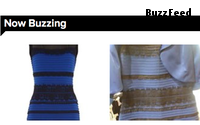Commentary
What If 'The Dress' Were An Ad?
- by Tyler Loechner , Staff Writer @mp_tyler, February 27, 2015
 For what it’s worth, I think the dress is white and gold.
For what it’s worth, I think the dress is white and gold.
This dress, I mean. The one that has given BuzzFeed over 28 million page views and counting, a new record for the company.
Has anything ever gone so viral, so fast? (Happy Friday, by the way.)
I’ve seen a theory floated that the dress post is really just another example of what BuzzFeed does best: native advertising.
It's not -- BuzzFeed does use the “sponsored” label for ads pretending to be content -- but I suppose it’s possible that some dress company posted the picture on Tumblr (which is where BuzzFeed found it), worked some viral magic and watched the whole thing explode.
To be clear: I do not think this is the case, and I’m not trying to give this theory legs. I don’t even know what company the dress is from, and if it were an ad, you know we would. But it’s worth playing the “what if” game with this one.
If it were an ad -- if it had a little “sponsored by DressCompanyX” tag at the top of the post -- would it have gone as viral?
I don’t see why that would have changed much of anything. It wasn’t some great piece of content that attracted the masses; it was a mind game that seemed like magic. People love things they can’t explain. I'm expecting native advertisers to try to recreate this magic in the coming weeks and months.
If it were an ad, how epic would John Oliver’s rant have been?
If it were an ad, would over 2.5 million people have voted on it? Maybe not. It’s hard to get 2.5 million people to vote about anything.
Per Politico.com, that’s more people than voted in 2014 Senate races in Alaska, Arkansas, Colorado, Delaware, Georgia, Hawaii, Idaho, Iowa, Kansas, Kentucky, Louisiana, Maine, Massachusetts, Minnesota, Mississippi, Montana, Nebraska, New Hampshire, New Jersey, New Mexico, Oklahoma, Oregon, Rhode Island, South Carolina, South Dakota, Tennessee, Virginia, West Virginia and Wyoming.
Yes, that’s every state that had a 2014 Senate race save for Illinois and Michigan. And dress voting wasn’t even open 24 hours ago, so it still has time to catch up.
"Once celebrities started discussing it, people could quickly weigh in because it was easy and it didn't require any thought, opinion or judgement,” commented Elaine Feeney, CEO of Wayin, a social media analytics firm. “When it comes to elections, your thoughts will be judged and are likely to be controversial.”
"The reason that #TheDress content took off is because it was posted with a clear call to action and the right tags to get influential eyeballs and quick response,” she added.
When everyone starts discussing it, you know the brands won’t be far behind. Companies such as Pizza Hut, Lego, Denny’s, Red Bull and others all chimed in with real-time marketing tweets.
Lego, which was the most talked about brand on social media during the Oscars last weekend, had the best tweet of the bunch:
#whiteandgold or #blackandblue? We
found a way around science- you can have both! #TheDress#dressgatepic.twitter.com/5oj3ZTqOWk
-- LEGO (@LEGO_Group) February 27, 2015Tide entered the party a little later, but they too managed to come up with a tweet that was on brand:
Looks like a problem when you don’t use Tide Plus ColorGuard. #TheDress#DressGatepic.twitter.com/yvUudF50mt
-- Tide (@tide) February 27, 2015If the post were an ad, we may not have seen brands joining the conversation on Twitter, but so what? They weren’t the ones driving the conversation. As Feeney of Wayin noted, it was the celebrities that really jumpstarted the conversation, coupled with the fact that it required no “thought, opinion or judgement” on behalf of the consumer.
Even without being a native ad, the post will likely to pointed to by native ad proponents as verification: "See the power of a viral post? A creative agency or brand could have come up with that, and it wouldn't have disenchanted consumers -- at least not most of them."
That's true.



